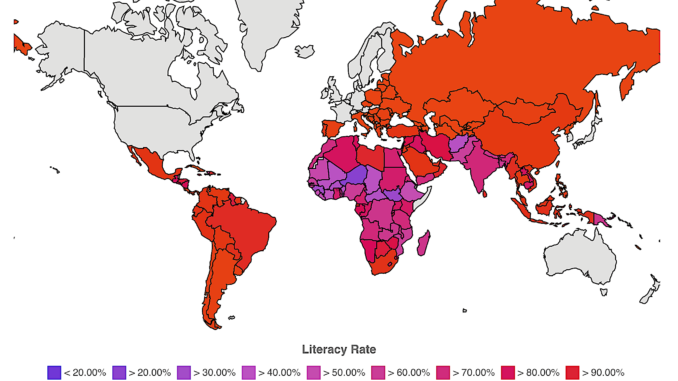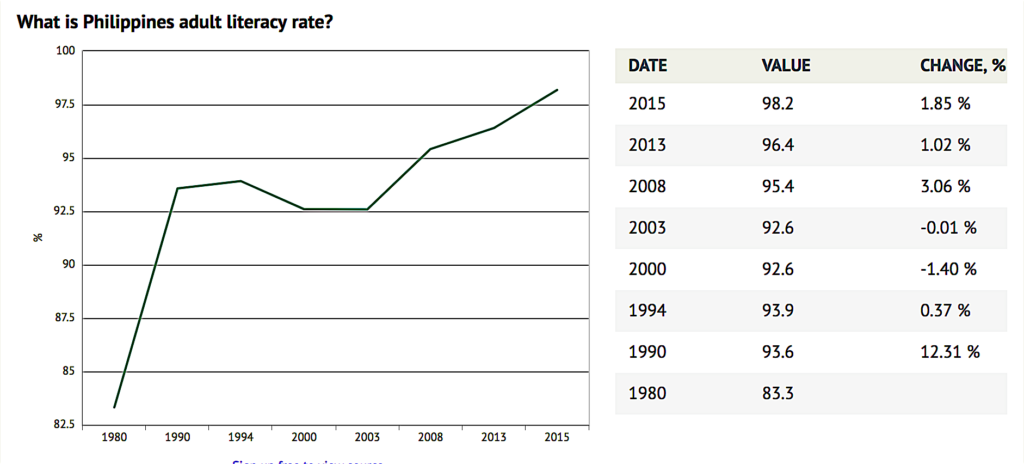
September 8 is International Literacy Day as declared by UNESCO.
Literacy is the ability to read and write common words found in daily life. Readers age 15 and older must be able to decipher, understand, and communicate simple text in numbers and letters. It seems basic but it’s not.
Globally, 773 million are illiterate. That’s 10 percent of the world who can’t read or write basic words. This inability excludes them from many jobs and opportunities that could elevate their lives. Literacy a marker of a nation’s potential for progress, productivity, and prosperity.
Men have a higher literacy rate (90 %) compared to women (82 %). The gap is wider in countries with very low literacy rates, where women make up nearly two-thirds of the illiterate. Households who lack funds prioritize the males’ education so they can work to support the family. Likewise, cultural norms inhibit women’s independence.
Literacy depends on access to quality education. This includes learning resources like internet, libraries, and books. Wealthy nations usually have almost perfect literacy rates, an average of 99.2 percent.
Here are select countries and their literacy rates (see table).
Countries with 100 % literacy rates are consistently led by rich European countries like Finland, Luxembourg, and Norway.
Then there’s Russia and its neighbors: Armenia, Azerbaijan, Belarus, Georgia, Kazakhstan, Slovakia, Slovenia, Tajikistan, Turkmenistan, Poland, Ukraine, Uzbekistan, and the Baltic states Estonia, Latvia, Lithuania.
It also includes Andorra, Cuba, Barbados, the Holy See, and North Korea.
At 99 % are the usual affluent countries: Australia, Belgium, Canada, Denmark, France, Germany, Iceland, Ireland, Italy, Netherlands, Sweden, Switzerland, and the United Kingdom.
Then the Czech Republic, Romania, New Zealand and Japan.
Also the islands Cyprus, Tuvalu, Samoa, Micronesia, Trinidad and Tobago, and Antigua & Barbuda in Guatemala.
It’s 98 % for Austria, Argentina, Bulgaria, Israel, Maldives, Spain, and South Korea.
Costa Rica, Chile, and Greece are at 97%.
Bahamas, Thailand, Singapore, and Qatar are at 96 %. Thailand ranks second in weekly reading at nine hours and 24 minutes.

World Data Atlas
Philippines and China
China and the Philippines tie at 95 %. Both dropped from their 2015 rate of 98% for PH and 97% for China.
PH improved from its 1990 rate of 93%.
The PH constitution mandates that it spend the biggest chunk of its budget on education. Last year, PH allotted $3.4 million or less than 2% of its GDP to education. The UN recommends 6% of GDP.
Since 2012, China spent over 4% of its GDP on education. Last year, it spent about $520 billion and it shows. In 2012, 2015, and 2018, China bested the world’s richest economies in the PISA, an international assessment of the OECD where the average income per capita is $30,500. PISA measures sample students age 15 in reading, math, and science in the world’s wealthiest nations.
Median income is the middle income where half the population has disposable income above and the other half below this number. The highest median per capita income is in Luxembourg with $38,516, then Norway and Switzerland. The first two have a 100% literacy rate and the third at 99%.
The median income in the US is $34,514, China is $1,786, and PH is $478.
Though PH population is 7.5% that of China and its median income is 26% less, PH is as much of an avid reader as China in the world. China ranks third in weekly reading with eight hours, while PH is fourth with seven hours and 36 minutes. But unlike China, PH placed last in the 2018 PISA in reading.
What happened to the US?
For a world power, the United States has a surprisingly average 86 % literacy rate but it reads as much as Germany for five hours and 42 minutes a week.
In 1998, the US had a higher literacy rate than Germany, UK, Switzerland, and Poland. Now, the first three have a high 99% literacy rate and Poland is at a 100%.
The US illiteracy rate is 14%, that’s higher than the global rate of 10%. Nearly half of Americans are functionally illiterate—they cannot fill out an application form or read a prescription medicine.
Higher illiteracy leads to delinquency. A fourth of US high school graduates cannot read, 85% of juveniles in the court system are functionally illiterate, 70% of prisoners cannot read above 4th grade level, and 90% on welfare are high school dropouts.
If released convicts are taught to be more literate, their recidivism decreases by 43 percent.
US would like to blame the non-English speaking immigrants for the lowering literacy rates, but a 2012 and 2014 study shows that 35% of US-born white American adults have a low-level English literacy, followed by 34% Hispanic, 10% of which are US-born. Without regard to race, 66% of US-born adults have low English literacy.
Literacy is key
India has a 69 % literacy rate, below the world average of 74%, yet it tops the world in weekly reading at 10 hours and 42 minutes. This is a great example of how reading contributes to India’s reputation as desirable workers for multinationals and tech companies.
Pakistan is 55 %, Nigeria 51 %. Côte d’Ivoire, where we get cocoa, is 41 %.
Somalia and Ethiopia are 39 %, Afghanistan is 32 %, and Niger is lowest at 15%. The rest could not participate nor be measured.
Literacy is the key to the digital door. Populations cannot work nor compete globally if they lack the essential skills to find information, comprehend data, follow directions, answer a written question, or compose a letter.
Increasing literacy is a concerted effort that begins at the top. Governments need to allot funds for public libraries, high schools, colleges, teachers, and non-profits to help adults reach their functional literacy. Businesses should have tax incentives for literacy programs for their workers. Language arts educators should have scholarships, and teachers should be paid competitively.
Reading is crucial in filling the gaps of inadequate schooling. The act of reading builds so many skills necessary for success: focus, discipline, critical thinking, imagination, memory, vocabulary, knowledge, empathy, and logic.
Raising literacy in adults is the same for children. We need plenty of exposure to print—in books, newspapers, magazines, and publications.
Even in the absence of quality schools, an abundance of good books is crucial. As proven by many self-educated greats throughout history who lived far from any school, one can become highly skilled through reading great books.
So let’s not take this gift for granted. I hope you visit your library, at home or in the community, and read a book to celebrate your literacy.
Help promote literacy and follow me on Instagram, FB, Twitter @IvyDigest.



